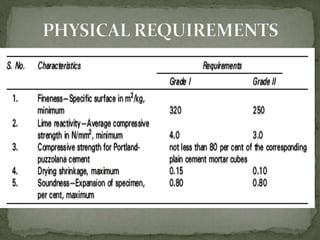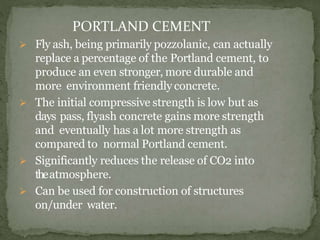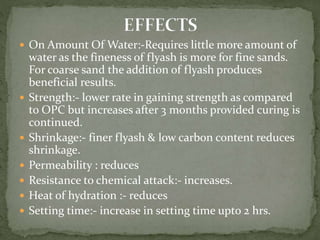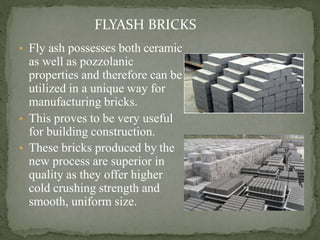Flyash
- 1. “FLYASH”
- 2. Puzzolona puzzouli, a town in italy near mount Vesuvious. Volcanic dust around this town when mixed with hydraulic lime was found to possess hydraulic or cementitious properties. Puzzolona may be defines as a siliceous material which whilst itself doesn’t possess cementitious properties. Before cement, these puzzolonas were mixed with lime. Puzzolonas may be natural or artificial, flyash being common in latter category. Currently, its use to replace some portion of cement in concrete.
- 3. ECONOMY WORKABILITY INCREASED REUCTION OF BLEEDING AND SEGREGATION GREATER IMPERVIOUSNESS RESISTANCE TO FREEZING AND THAWING RESISTANCE TO ATTACK SULPHATES & WATERS. REDUCED EFFECTS OF ALKALI AGGREGATE REACTION REDUCED HEAT OF HYDRATION REDUCED COSTS LOCALLY OBTAINED
- 4. NATURAL CLAY SHALES DIATOMACEOUS EARTH VOLCANIC TUFF & PUMICITES RHENISH AND BAVARIAN TRASS ARTIFICIAL FLYASH GROUND BLAST FURNACE SLAG SILICA FUME SURKHI RICE HUSK ASH
- 5. When mixed with OPC, the silica of puzzolona combines with free lime released during the hydration of cement, called puzzolonic action. The silica contributes to development of strength. Slowly additional calcium silicate hydrate is formed which is a binder and fills up the space, gives impermeability, durability and increase in strength. Silica of amorphous form reacts with lime readily than those of crystalline form.
- 6. The optimum amount of puzzolona, as replacement for cement may normally range between 10-30 %. Enough moisture has to be made available for a long time to complete puzzolonic action. Chief application where heat of hydration is to be reduced and slower rate of gain in strength is not an issue, mass concreting like dams, massive foundations, retaining walls etc.,
- 8. Pulverised fuel ash (PFA) Comprises of fine particles which rise with theflue gases. Reisdue from combustion of pulverised coal collected by electro static separators from power plants. Finer than OPC. Consists of spherical particles or irregular shaped particles. Light grey to dark grey or even brown. Also used as admixture. Carbon content should be as low as possible.
- 9. It is a heterogeneous material containing SiO2, Al2O3 and Fe2O3 as major constituents with CaO occasionally being the minor constituent. Exact composition varies according to the parent coal bed makeup. Also has Arsenic, Beryllium, Cadmium, Chromium, Cobalt, Mercury, Molybdenum, Selenium, Strontium, etc (in the order of hundred ppm). Component(%) Bituminous Sub-Bituminous Lignite SiO2 20-60 40-60 15-45 Al2O3 5-35 20-30 20-25 Fe2O3 10-40 4-10 4-15 CaO 1-12 5-30 15-40 CHEMICAL COMPOSITION
- 11. Fineness should be as high as possible because the silica in flyash combines slowly over a very long period with lime liberated during hydration process. Curing at a temperature of 38 degrees C has been found to greatly accelerate its contribution to the strength of concrete. Flyash is supplied in two grades:- grade I & grade II. Grade I is recommended for manufacturing of OPC. Grade II is used in cement mortar & as admixture in concrete.
- 12. Spherical glassy materials ranging from 1 to 150 micron, most of which passes through a 45 micron sieve. More than 40 % of the particles which are under 10 microns contribute to early age strength. Particles of sizes 10 to 45 microns reacts slowly and are responsible for gain in strength from 28 days to one year.
- 14. Admixture for Portland Cement Soil Stabilization Flyash Bricks Asphalt Concrete Embankments Geopolymers As a catalyst Waste Treatment
- 15. Fly ash, being primarily pozzolanic, can actually replace a percentage of the Portland cement, to produce an even stronger, more durable and more environment friendly concrete. The initial compressive strength is low but as days pass, flyash concrete gains more strength and eventually has a lot more strength as compared to normal Portland cement. Significantly reduces the release of CO2 into theatmosphere. Can be used for construction of structures on/under water. PORTLAND CEMENT
- 16. On Amount Of Water:-Requires little more amount of water as the fineness of flyash is more for fine sands. For coarse sand the addition of flyash produces beneficial results. Strength:- lower rate in gaining strength as compared to OPC but increases after 3 months provided curing is continued. Shrinkage:- finer flyash & low carbon content reduces shrinkage. Permeability : reduces Resistance to chemical attack:- increases. Heat of hydration :- reduces Setting time:- increase in setting time upto 2 hrs.
- 17. 10 0 20 30 60 50 40 3 7 28 56 90 180 Plain Cement Concrete Flyash Concrete
- 18. Soil stabilization is the alteration of soil properties to improve the engineering performance of soils. Modification of soil properties is the temporary enhancement of sub-grade stability to speedup construction. Stabilization can increase the shear strength of a soil and/or control the shrink-swell properties of a soil, thus improving the load-bearing capacity of a sub- grade to support pavements andfoundations. Stabilization can be used to treat a wide range of sub- grade materials from expansive clays to granular materials. SOIL STABILIZATION & MODIFICATION
- 20. • Fly ash possesses both ceramic as well as pozzolanic properties and therefore can be utilized in a unique way for manufacturing bricks. • This proves to be very useful for building construction. • These bricks produced by the new process are superior in quality as they offer higher cold crushing strength and smooth, uniform size. FLYASH BRICKS
- 21. S.NO FEATURES NORMALCLAY BRICKS FLYASHBRICKS 1 BINDING LIGHT DENSE 2 COLOUR VARY UNIFORM 3 SHAPE IRREGULAR UNIFORM 4 WEIGHT MORE LESS 5 COMPRESSIVE STRENGTH 35KGS/SQ.CM 100KGS/SQ.CM 6 WATER ABSORPTION 20-25% 6-12%
- 22. a) In terms of usability in Concrete and Cement: Higher Ultimate Strength Increased Durability Improved Workability Reduced Bleeding Increased Resistance to SulfateAttack Reduced Shrinkage Almost zero emission of greenhouse gases. ADVANTAGES
- 23. Reduces excavation of clay. Low cost of brick as compared to clay brick of same quality. Number of bricks required per unit volume of construction is less as dimensional accuracy is maintained. Lesser consumption of mortar. Better resistance to water damage.
- 24. Reduces soil erosion by replacing top soil asingredients for most construction mixes. Reduces pollution measure by re-use of wastes. Reduces the amount of greenhouse gases being added to the atmosphere. Hydrophobic nature helps in proper draining off ofwater from roads and structures. Production of crude oil frompolyethylene. Also used in sewage treatment and generation ofbiofuel as an alternate source of energy resource.
- 25. Groundwater contamination due torunoffs carrying ill-treated flyash. Cannot be used for structures requiring shorter setting time, a demand which is expected by most of the engineers and builders. Air content control plays a vital role and can prove crucial for the quality of flyash concrete. Toomuch reduction in air content can be disastrous. It is very difficult to use in winter season due to further increase in already longer setting time. Difficult to control colour of cement containing flyash. Hence, a bit problematic to use where cosmetic quality plays a significant role. DISADVANTAGES
- 26. Flyash can be proclaimed as one of the mostadvantageous waste material. Using it as a construction material will not only help inits disposal but will also add strength and durablity of structures. Since, the current usage of flyash in India is still around 25%and below 45% even in the developed countries like United States, there is a huge scope for flyash in upcoming years. So let us harness a billion dollar resource that has beenwasted so far. CONCLUSION


























